月球探测器列表
本表列出迄今为止所有为探测月球而发射并在月球完成飞掠、环绕、撞击或软着陆当中任何一项的月球探测器以及已经发射但因事故而未能完成上述目标的所有探测器。
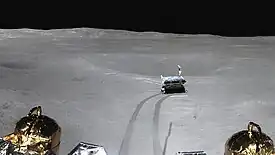
嫦娥四号拍摄到的月表景象
载人绕月和登月任务以及不以探测月球为目的的飞掠或撞击任务列入前往月球的航天任务列表。
目前已多次发射月球探测器的主要月球探测计划或工程包括:
说明
色块:
– 任务部分或完全完成 – 任务失败或已取消 – 任务正在进行中(包括任务延长) – 计划中的任务
- †意为“暂时鉴别”(根据NASA的分类 (页面存档备份,存于))。这类分类当中大多是冷战时期苏联发射的任务,其中大部分都是失败的,官方几乎或完全没有公布相关细节。所提供的信息可能是推测性的 。
- 日期是指以下事件发生的时间:
- 达到最近距离(飞掠)
- 撞击月表(撞击器)
- 进入月轨至任务结束期间的时间,无论其发生时间是计划内的还是过早或过迟的(轨道器)
- 着陆月面至任务结束期间的时间,无论其发生时间是计划内的还是过早或过迟的(软着陆器)
- 发射时间(由于发射时或发射后不久出现故障导致从未真正到达月球的任务)
- 如若不符合上述的任何一种情况,则说明日期所指的事件。请注意,因为此安排的影响,任务列表并不总是按照发射时间的顺序列出。
- 对于主任务飞行程序中附带的飞掠(例如重力辅助等),“成功”表示该飞越的成功完成,而不一定是主要任务的成功完成。
列表
1958年–1960年
| 航天器名称 | 国家/机构 | 日期 | 原定任务类型 | 结果/当前状态 | 备注 | 图片 | 参考 | |
|---|---|---|---|---|---|---|---|---|
| 先驱者0号 | 1958年8月17日 | 环绕 | 失败 | 首次尝试往地球轨道之外发射航天器;运载火箭故障;最高海拔16 千米 | ABLE1 | |||
| 月球1A号 | 1958年9月23日 | 撞击 | 失败 | 运载火箭故障 | ||||
| 先驱者1号 | 1958年10月11日 | 环绕 | 失败 | 二级发动机提前关闭;最大高度113,800 千米;部分收集数据传回 |  |
1958-007A | ||
| 月球1B号 | 1958年10月12日 | 撞击 | 失败 | 运载火箭故障 | ||||
| 先驱者2号 | 1958年11月8日 | 环绕 | 失败 | 三级火箭故障;最大高度1,550 千米;部分收集数据传回 | PION2 | |||
| 月球1C号 | 1958年12月4日 | 撞击 | 失败 | 运载火箭故障 | ||||
| 先驱者3号 | 1958年12月6日 | 飞掠 | 失败 | 燃料泄露;最大高度102,360 千米;部分收集数据传回 |  |
1958-008A | ||
| 月球1号 | 1959年1月4日 | 飞掠 | 部分成功 | 第一艘在月球附近飞行的航天器(飞行速度为5,995 千米;可能原本是作为撞击器发射的) | 1959-012A | |||
| 先驱者4号 | 1959年3月4日 | 飞掠 | 部分成功 | 成功实现远距离飞掠;美国首个进入太阳轨道的探测器 |  |
1959-013A | ||
| 月球2A号 | 1959年6月18日 | 撞击 | 失败 | 未能成功发射入轨 | (页面存档备份,存于) | |||
| 月球2号 | 1959年9月14日 | 撞击 | 成功 | 首次完成对月球的撞击 | 1959-014A | |||
| 先驱者P-1 | 1959年9月24日? | 环绕? | 失败 | 可能因发射失败或测试期间的发射台爆炸导致任务失败;不同来源之间的信息存在冲突 | ||||
| 月球3号 | 1959年10月6日 | 飞掠 | 成功 | 首次拍摄到了月球背面的照片 | 1959-008A | |||
| 先驱者P-3 | 1959年11月26日 | 环绕 | 失败 | 发射后不久在空中解体 | PIONX | |||
| 月球4A号† | 1960年4月15日 | 飞掠 | 失败 | 发射中未能按正确轨迹飞行 | (页面存档备份,存于) | |||
| 月球4B号† | 1960年4月16日 | 飞掠 | 失败 | 运载火箭故障 | (页面存档备份,存于) | |||
| 先驱者P-30 | 1960年9月25日 | 环绕 | 失败 | 二级火箭故障导致未能入轨 | PIONY | |||
| 先驱者P-31 | 1960年12月15日 | 环绕 | 失败 | 一级火箭故障 | PIONZ | |||
已隱藏部分未翻譯内容,歡迎參與翻譯。
1962年–1965年
| Spacecraft | Organization | Date | Type | Status | Notes | Image | Ref | |
|---|---|---|---|---|---|---|---|---|
| Ranger 3 | 28 January 1962 | impactor | failure | missed target |  |
1962-001A | ||
| Ranger 4 | 26 April 1962 | impactor | failure | hit the lunar farside; no data returned | 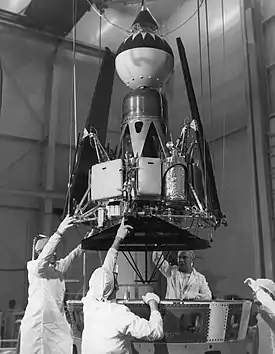 |
1962-012A | ||
| Ranger 5 | 21 October 1962 | impactor | failure | power failure, missed target | 1962-055A | |||
| Sputnik 25 | 5 January 1963 | lander | failure | failed to escape Earth orbit | 1963-001A | |||
| Luna E-6 No.3† | 2 February 1963 | lander? | failure | failed to reach Earth orbit | (页面存档备份,存于) | |||
| Luna 4 | 5 April 1963 | lander? | failure | missed target, became Earth satellite | 1963-008B | |||
| Ranger 6 | 2 February 1964 | impactor | partial success | impacted, but no pictures returned due to power failure |  |
1964-007A | ||
| Luna 1964A† | 21 March 1964 | lander | failure | failed to reach Earth orbit | ||||
| Ranger 7 | 31 July 1964 | impactor | success | returned pictures until impact |  |
1964-041A | ||
| Ranger 8 | 20 February 1965 | impactor | success | returned pictures until impact |  |
1965-010A | ||
| Cosmos 60 | 12 March 1965 | lander | failure | failed to leave Earth orbit | 1965-018A | |||
| Ranger 9 | 24 March 1965 | impactor | success | TV broadcast of live pictures until impact |  |
1965-023A | ||
| Luna 1965A† | 10 April 1965 | lander? | failure | failed to reach Earth orbit? | (页面存档备份,存于) | |||
| Luna 5 | 12 May 1965 | lander | failure | crashed into Moon | 1965-036A | |||
| Luna 6 | 8 June 1965 | lander | failure | missed Moon | 1965-044A | |||
| Zond 3 | 20 July 1965 | flyby | success | possibly originally intended as a Mars probe, but target changed after launch window missed | 1965-056A | |||
| Luna 7 | 7 October 1965 | lander | failure | crashed into Moon | 1965-077A | |||
| Luna 8 | 6 December 1965 | lander | failure | crashed into Moon | 1965-099A | |||
1966年–1967年
| Spacecraft | Organization | Date | Type | Status | Notes | Image | Ref | |
|---|---|---|---|---|---|---|---|---|
| Luna 9 | 3 February 1966 – 6 February 1966 |
lander | success | first soft landing; first images from the surface | 1966-006A | |||
| Cosmos 111 | 1 March 1966 | orbiter | failure | failed to escape Earth orbit | 1966-017A | |||
| Luna 10 | 3 April 1966 – 30 May 1966 |
orbiter | success | first artificial satellite of the Moon | 1966-027A | |||
| Luna 1966A† | 30 April 1966 | orbiter? | failure | failed to reach Earth orbit | (页面存档备份,存于) | |||
| Surveyor 1 | 2 June 1966 | lander | success | first US soft landing; Surveyor program performed various tests in support of forthcoming human landings |  |
1966-045A | ||
| Explorer 33 | 1 July 1966 – 15 September 1971 |
orbiter | partial success | studied interplanetary plasma, cosmic rays, magnetic fields and solar X rays; failed to attain lunar orbit as intended, but achieved mission objectives from Earth orbit | 1966-058A | |||
| Lunar Orbiter 1 | 14 August 1966 – 29 October 1966 |
orbiter | success | photographic mapping of lunar surface; intentionally impacted after completion of mission | 1966-073A | |||
| Luna 11 | 28 August 1966 – 1 October 1966 |
orbiter | success | gamma-ray and X-ray-based observations of Moon's composition; gravity, radiation and meteorite studies | 1966-078A | |||
| Surveyor 2 | 23 September 1966 | lander | failure | crashed into Moon |  |
1966-084A | ||
| Luna 12 | 25 October 1966 – 19 January 1967 |
orbiter | success | lunar surface photography | 1966-094A | |||
| Lunar Orbiter 2 | 10 November 1966 – 11 October 1967 |
orbiter | success | photographic mapping of lunar surface; intentionally impacted after completion of mission | 1966-100A | |||
| Luna 13 | 24 December 1966 | lander | success | TV pictures of lunar landscape; soil measurements | 1966-116A | |||
| Lunar Orbiter 3 | 8 February 1967 – 9 October 1967 |
orbiter | success | photographic mapping of lunar surface; intentionally impacted after completion of mission | 1967-008A | |||
| Surveyor 3 | 20 April 1967 – 4 May 1967 |
lander | success | various studies, primarily in support of forthcoming human landings. First lander visited by a later crewed mission (Apollo 12) that even brought its components back to Earth. | 1967-035A | |||
| Lunar Orbiter 4 | May–October 1967 | orbiter | success | lunar photographic survey | 1967-041A | |||
| Explorer 35 | July 1967 – 24 June 1973 |
orbiter | success | studies of interplanetary plasma, magnetic fields, energetic particles and solar X rays |  |
1967-070A | ||
| Surveyor 4 | 17 July 1967 | lander | failure | crashed into Moon |  |
1967-068A | ||
| Lunar Orbiter 5 | 5 August 1967 – 31 January 1968 |
orbiter | success | lunar photographic survey; intentionally impacted after completion of mission | 1967-075A | |||
| Surveyor 5 | 11 September 1967 – 17 December 1967 |
lander | success | various studies, primarily in support of forthcoming human landings |  |
1967-084A | ||
| Zond 1967A† | 28 September 1967 | failure | lunar capsule test flight; launch failure | (页面存档备份,存于) | ||||
| Surveyor 6 | 10 November 1967 – 14 December 1967 |
lander | success | various studies, primarily in support of forthcoming human landings |  |
1967-112A | ||
| Zond 1967B† | 22 November 1967 | failure | lunar capsule test flight; launch failure | (页面存档备份,存于) | ||||
1968年–1970年
| Spacecraft | Organization | Date | Type | Status | Notes | Image | Ref | |
|---|---|---|---|---|---|---|---|---|
| Surveyor 7 | 10 January 1968 – 21 February 1968 |
lander | success | various studies, primarily in support of forthcoming human landings; fifth and final Surveyor mission to achieve soft landing |  |
1968-001A | ||
| Luna 1968A† | 7 February 1968 | orbiter? | failure | failed to reach Earth orbit | (页面存档备份,存于) | |||
| Zond 4 | 2 March 1968 (launch) | lunar programme flight test, directed away from Moon, either intentionally or unintentionally | 1968-013A | |||||
| Luna 14 | 10 April 1968 – ? | orbiter | success | tests of radio communications technologies; lunar mascon studies | 1968-027A | |||
| Zond 1968A† | 23 April 1968 | flyby? | failure | launch failure | (页面存档备份,存于) | |||
| Zond 5 | 18 September 1968 | flyby | success | bioscience experiments; returned to soft landing on Earth | 1968-076A | |||
| Zond 6 | 14 November 1968 | flyby | success | cosmic-ray, micrometeoroid and bioscience studies; returned to soft landing on Earth | 1968-101A | |||
| Zond 1969A† | 20 January 1969 | flyby | failure | launch aborted | (页面存档备份,存于) | |||
| Luna 1969A† | 19 February 1969 | lander | failure | launch vehicle failure | (页面存档备份,存于) | |||
| Lunokhod 201† | rover | failure | ||||||
| Zond L1S-1† | 21 February 1969 | orbiter | failure | launch vehicle failure | (页面存档备份,存于) | |||
| Luna 1969B† | 15 April 1969 | sample return? | failure | launch failure | (页面存档备份,存于) | |||
| Luna 1969C† | 14 June 1969 | sample return | failure | launch failure | (页面存档备份,存于) | |||
| Zond L1S-2† | 3 July 1969 | orbiter | failure | launch failure | (页面存档备份,存于) | |||
| Luna 15 | 21 July 1969 | sample return? | failure? | completed 52 lunar orbits then crash-landed | 1969-058A | |||
| Zond 7 | 11 August 1969 | flyby | success | returned to soft landing on Earth | 1969-067A | |||
| Cosmos 300 | 23 September 1969 | sample return | failure | failed to escape Earth orbit | 1969-080A | |||
| Cosmos 305 | 22 October 1969 | sample return | failure | failed to escape Earth orbit | 1969-092A | |||
| Luna 1970A† | 6 February 1970 | sample return? | failure | launch vehicle failure | (页面存档备份,存于) | |||
| Luna 1970B† | 19 February 1970 | orbiter? | failure | launch vehicle failure | (页面存档备份,存于) | |||
| Luna 16 | 20 September 1970 | sample return | success | first robotic sample return | 1970-072A | |||
| Zond 8 | 24 October 1970 | flyby | success | returned to soft landing on Earth | 1970-088A | |||
| Luna 17 | 17 November 1970 – 4 October 1971 |
lander | success | deployed rover | 1970-095A | |||
| Lunokhod 1 | rover | success | first robotic rover; travelled over 10 km | 1970-095D | ||||
1971年–1976年
| Spacecraft | Organization | Date | Type | Status | Notes | Image | Ref | |
|---|---|---|---|---|---|---|---|---|
| Luna 18 | 11 September 1971 | lander/sample return? | failure | crashed into Moon | 1971-073A | |||
| Luna 19 | 3 October 1971 – October 1972 |
orbiter | success | 1971-082A | ||||
| Luna 20 | 21 February 1972 | sample return | success | second successful robotic sample return | 1972-007A | |||
| Soyuz L3† | 23 November 1972 | orbiter | failure | launch failure | (页面存档备份,存于) | |||
| Luna 21 | 15 January 1973 – May 1973? |
lander | success | deployed rover | 1973-001A | |||
| Lunokhod 2 | rover | success | second robotic rover; travelled 37 km | |||||
| Explorer 49 | 15 June 1973 – June 1975 |
orbiter | success | radio astronomy observations; last US lunar mission until 1994 |  |
1973-039A | ||
| Mariner 10 | November 1973 | flyby | success | en route to Venus and Mercury | 1973-085A | |||
| Luna 22 | 2 June 1974 – November 1974 |
orbiter | success | 1974-037A | ||||
| Luna 23 | 6 November 1974 | sample return | failure | damaged on landing, sample return failed | 1974-084A | |||
| Luna 1975A† | 16 October 1975 | sample return | failure | failed to reach Earth orbit | (页面存档备份,存于) | |||
| Luna 24 | 18 August 1976 | sample return | success | third and final successful sample return in Luna programme | 1976-081A | |||
1983年–1998年
| Spacecraft | Organization | Date | Type | Status | Notes | Image | Ref | |
|---|---|---|---|---|---|---|---|---|
| ICE (formerly ISEE-3) | 22 December 1983 | flyby | success | gravity assist en route to comet flybys | 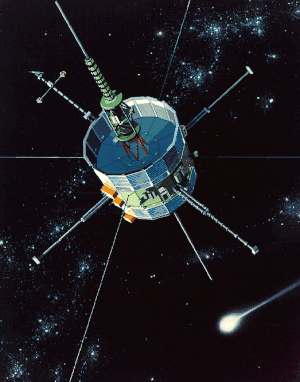 |
1978-079A | ||
| Hiten | March 1990 – October 1991 | flyby (approached 10 times) | success | in Moon-crossing Earth orbit from January 1990, later transferred to lunar orbit after failure of Hagoromo; intentionally impacted on Moon at end of mission; first Japanese probe (and non-USSR/US probe) to enter lunar orbit | 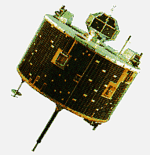 |
1990-007A | ||
| February 1992 – April 1993 | orbiter | success | ||||||
| Hagoromo | March 1990 | orbiter | failure | released by Hiten into lunar orbit, but transmitter failed and orbit never confirmed | ||||
| GEOTAIL | September 1992 – November 1994 | flyby (approached 14 times) | success | gravity assist en route magnetotail around L2 / finally deployed into high Earth orbit | (页面存档备份,存于) | |||
| WIND | 1 December 1994 and 27 December 1994 | flyby | success | gravity assists en route to Earth–Sun L1 Lagrangian point | 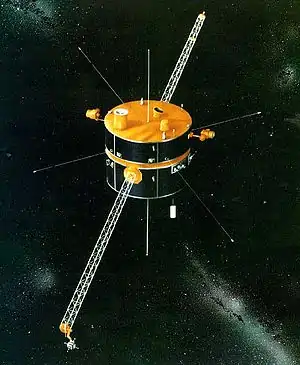 |
1994-071A | ||
| Clementine | February – June 1994 | orbiter | partial success | lunar and Earth observations and component testing; planned Geographos flyby failed | 1994-004A | |||
| HGS-1 | May/June 1998 | Flyby (orbital correction) | errant communications satellite, flew within 6,200 kilometers of Moon during orbit correction manoeuvres | 1997-086A | ||||
| Lunar Prospector | January 1998 – July 1999 |
orbiter | success | lunar surface mapping; intentionally impacted into polar crater at end of mission to test for liberation of water vapour (not detected) | 1998-001A | |||
| Nozomi | 24 September 1998 | flyby | success | gravity assists on planned mission to Mars | 1998-041A | |||
| 18 December 1998 | flyby | success | ||||||
2001年–2009年
| Spacecraft | Organization | Date | Type | Status | Notes | Image | Ref | |
|---|---|---|---|---|---|---|---|---|
| WMAP | 30 July 2001 | flyby | success | gravity assist en route to Earth–Sun L2 Lagrangian point | 2001-027A | |||
| SMART-1 | 13 November 2004 – 3 September 2006 |
orbiter | success | technology testbed and lunar geological studies; intentionally impacted at end of mission; first European probe to orbit the Moon | 2003-043C | |||
| STEREO A | 15 December 2006 | flyby | success | gravity assist to enter a heliocentric orbit | 2006-047A | |||
| STEREO B | 15 December 2006 and 21 January 2007 | flyby | success | gravity assists to enter a heliocentric orbit | 2006-047B | |||
| SELENE (Kaguya) |
3 October 2007 – 10 June 2009 | orbiter | success | mineralogical, geographical, magnetic and gravitational observations | 2007-039A | |||
| Okina (Relay Star) |
9 October 2007 – 12 February 2009 | Kaguya subsatellite | success | relay for Kaguya's Far Side operations | ||||
| Ouna (VRAD) |
12 October 2007 – 29 June 2009 | Kaguya subsatellite | success (still in orbit) | Very Long Baseline Interferometry | ||||
| Chang'e 1 | 5 November 2007 – 1 March 2009 | orbiter | success | 3D lunar mapping and geological observations; first Chinese probe to orbit a body besides Earth; impacted to collect data in preparation for future soft landings | 2007-051A (页面存档备份,存于) | |||
| Chandrayaan-1 | 8 November 2008 – 29 August 2009 | orbiter | success | high resolution 3D mapping, search water in polar region (first detection of water) and spectral analysis of the Moon's surface and inner compositions[1] | 2008-052A 的存檔,存档日期2014-04-12. | |||
| Moon Impact Probe (MIP) | 14 November 2008 | impactor | success | test and demonstrate targeting technologies for future soft landings, scientific observation from close range | ||||
| Lunar Reconnaissance Orbiter | 23 June 2009 – | orbiter | in orbit | survey of lunar resources and identification of possible landing sites | 2009-031A | |||
| LCROSS | 23 June 2009 | flyby | success | consisted of the Shepherding Spacecraft and Centaur upper stage (Earth Departure Upper Stage) |  |
2009-031B | ||
| LCROSS Shepherding Spacecraft | 9 October 2009 | impactor | success | analyzed upper-stage impact plume for traces of water liberated from the Moon's surface | ||||
| LCROSS Earth Departure Upper Stage | 9 October 2009 | impactor | success | |||||
2010年–2019年
| Spacecraft | Organization | Date | Type | Status | Notes | Image | Ref | |
|---|---|---|---|---|---|---|---|---|
| Chang'e 2 | 1 October 2010 – 27 August 2011 | orbiter | success | capture high resolution images of the landing zone for Chang'e 3, measure and analyze composition of the surface. Then sent to L2 and on to an asteroid flyby. | 2010-050A | |||
| ARTEMIS P1 | 2 July 2011 – | orbiter | in orbit | to study the effect of the solar wind on the lunar surface | 2007-004B (页面存档备份,存于) | |||
| ARTEMIS P2 | 17 July 2011 – | orbiter | in orbit | to study the effect of the solar wind on the lunar surface | 2007-004C (页面存档备份,存于) | |||
| GRAIL A (Ebb) |
31 December 2011 – 17 December 2012 | orbiter | success | mapped the Moon's gravitational field; intentionally impacted at end of mission | 2011-046A | |||
| GRAIL B (Flow) |
1 January 2012 – 12 December 2012 | orbiter | success | mapped the Moon's gravitational field; intentionally impacted at end of mission | 2011-046B | |||
| LADEE | 6 September 2013 – 8 April 2014 | orbiter | success | designed to study the lunar exosphere and dust. Intentionally impacted on far side of Moon. | 2013-047A | |||
| Chang'e 3 | 1 December 2013 - | lander | in progress | soft-landed on the Moon and deployed Yutu rover on 14 December 2013; one functioning instrument as of 1 September 2020 (页面存档备份,存于) | 2013-070A (页面存档备份,存于) | |||
| Yutu | 1 December 2013 – 2016? |
rover | success | survived multiple lunar nights, became immobile 42 days after landing | 2013-070C | |||
| Chang'e 5-T1 | 28 October 2014 | flyby | success | Technology demonstrator for Chang'e 5 mission; after separating the Xiaofei reentry capsule, the service module eventually entered lunar orbit to conduct rendezvous exercises | 2014-065A (页面存档备份,存于) | |||
| 10 January 2015 – | orbiter | in progress | ||||||
| Manfred Memorial Moon Mission | October 2014 | flyby/impactor (post mission) | success | privately funded payload attached to a Long March 3C rocket third stage; its dosimeter measured ionizing radiation in space. Unintentional Impact on 4 March 2022. | (页面存档备份,存于) (页面存档备份,存于) | |||
| TESS | 17 May 2018 | flyby | success | gravity assist to achieve a lunar resonant high Earth orbit | 2018-038A | |||
| Queqiao | 25 May 2018 | flyby | success | Used a gravity assist en route to the Earth–Moon L2 Lagrangian point. Currently serving as relay for Chang'e 4 lander and rover on the far side. | 2018-045A | |||
| Longjiang-1 | 25 May 2018 | orbiter | failure | malfunctioned after launch, became flyby | 2018-045B | |||
| Longjiang-2 | 25 May 2018 – 31 July 2019 | orbiter | success | Very Long Baseline Interferometry, in orbit until 31 July 2019 when it was deliberately directed to crash onto the Moon. | 2018-045C | |||
| Chang'e 4 | 7 December 2018 – | lander | in progress | First spacecraft to soft land on the far side of the Moon. | 2018-103A | |||
| Yutu-2 | rover | active | ||||||
| Beresheet | 22 February 2019 – 11 April 2019 | lander | failure | First Israeli and privately funded lunar lander. Entered lunar orbit on 4 April, hard-landed on 11 April 2019. | 2019-009B (页面存档备份,存于) | |||
| Chandrayaan-2 | 22 July 2019 – | orbiter | in orbit | observe lunar geography and mineralogy, search for water molecules | 2019-042A | |||
| Vikram | 6 September 2019 | lander | failure | crashed due to a software glitch[2] | ||||
| Pragyan | 7 September 2019 | rover | not deployed | was to be deployed from Vikram | ||||
2020年至今
| 航天器名称 | 国家/机构 | 日期 | 原定任务类型 | 结果/当前状态 | 备注 | 图片 | 参考 | |
|---|---|---|---|---|---|---|---|---|
| 嫦娥五号 | 2020年12月16日 | 采样返回 | 成功 | 帶回了約1.731 千克的月壤样本至地球 | 2020-087A[3] | |||
| 嫦娥五号着陆器 | 2020年11月30日 - 2020年12月11日 | 成功 | 获取月球样本并放置在上升器上; 对月面以下结构进行雷达研究 | |||||
| 嫦娥五号上升器 | 2020年12月3日 - 2020年12月7日 | 成功 | 通过月轨交会对接将月壤样本转移至返回器中;任务结束后主动离轨 | |||||
| 嫦娥五号轨道器 | 2021年9月9日 | 飞掠 | 成功 | 与返回器分离后进行拓展任务;从日地L1点[4]返回后进行了近月飞掠[5] | ||||
| 嫦娥五号轨道器 | 2021年后半- | 环绕 | 运行中 | 首个环绕地月L1和L2点远距离逆行轨道(DRO)的航天器 | ||||
| CAPSTONE | 2022年11月14日[6] | 环绕[7][8] | 运行中 | 用于测试和验证月球门户空间站计算过的轨道稳定性的立方星 | CAPSTONE | |||
| 阿耳忒弥斯1号猎户座MPCV CM-002 | 2022年11月21日 | 飞掠 | 成功 | 无人的猎户座飞船在月球附近进行飞掠和远距离逆行轨道运行的测试。 | ARTEMIS-1[9] | |||
| 2022年11月25日 | 环绕 | 成功 | ||||||
| 2022年12月5日 | 飞掠 | 成功 | ||||||
| 月球极地氢测绘仪 | 2022年11月21日(飞掠) | 环绕 | 失败 | 原计划通过变轨后进入月球轨道,并使用中子探测器在永夜坑内寻找月球水冰的证据。变轨失败可能是由于阀门受到撞击。任务在探测器于太阳轨道运行六个月后正式终止。 | LUNAH-MAP[10][11] | |||
| 月球冰立方 | 2022年11月21日(飞掠) | 环绕 | 失败 | 原计划通过变轨后进入月球轨道,并使用其红外光谱仪检测月表和外逸层中的水和有机化合物。 |  |
L-ICECUBE | ||
| EQUULEUS | 2022年11月21日 | 飞掠 | 成功 | 地球等离子层、月背撞击坑以及L2实验的成像。 | EQUULEUS | |||
| LunIR | 2022年11月21日 | 飞掠 | 失败 | 图像表面热成像,由于通讯故障未能观测到月球 | LUNIR[12] | |||
| NEA Scout | 2022年11月21日 | 飞掠 | 失败 | 太阳帆,原计划飞掠一颗近地小行星。通讯故障。 | NEA-SCOUT | |||
| ArgoMoon | 2022年11月21日 | 飞掠 | 成功 | 对SLS的二级火箭进行成像并进行深空纳米技术实验。 | ARGOMOON | |||
| OMOTENASHI 固体电机和轨道模块 | 2022年11月21日(飞掠) | 撞击 | 失败 | 计划与月面模块分离后主动撞月。同时为月面模块的着陆轨迹做准备。通讯失败,错过目标 | OMOTENASH | |||
| OMOTENASHI 月面模块 | 半硬着陆 | 失败 | 充气式的半硬着陆器。通讯失败,错过目标 | |||||
| 赏月号 (韓國探路者月球軌道探測器) |
2022年12月16日[13] | 环绕 | 运行中 | 韩国航空宇宙研究院 (KARI) 的月球轨道飞行器。轨道器及其有效科学载荷和地面控制设施是技术演示器。该轨道器还将承担勘察水冰、铀、氦-3、硅以及铝等月球资源的任务,并绘制地形图以协助未来月球着陆器着陆点的选择。 | KPLO | |||
| 白兔-R M1 | 2023年4月 | 着陆 | 失败[14] | 月球着陆器技术演示。 | HAKUTO-R1 | |||
| 拉希德號月球車 | 2023年4月 | 巡视 | 失败 | 月球车,酋长国月球任务的一部分。 | ||||
| SORA-Q | 2023年4月 | 巡视 | 失败 | 月球巡视车技术演示。 | ||||
| 月球手电筒 | 2022年12月11日(发射) | 环绕 | 失败[15][16] | 原计划将进入近直线晕轨道;由于推进器故障导致无法离开地球轨道。 | L-FLASHLT | |||
| 月船3号 | 2023年7月14日(发射) 2023年8月5日(进入月轨) |
环绕 | 运行中 | 将着陆器从地球停泊轨道运至着陆前100 km(62 mi)的月球轨道,并在月轨研究地球的光谱和偏振测量。 | 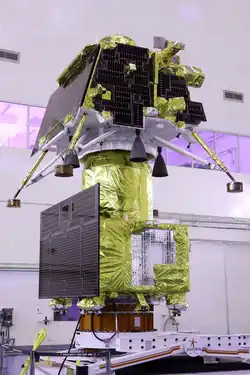 |
CHANDRYN3 | ||
| 维克拉姆号着陆器 | 2023年8月23日 | 着陆 | 成功 | 主要目标是完成已经失败的月船2号的着陆。此外还将对月表可用的材料进行现场观察和实验,以更好地了解月球的构成。 | ||||
| 普拉冈号月球车 | 2023年8月23日 | 巡视 | 成功 | 预先放置在着陆器内。展示月球车在月面的徘徊能力。对月表可用的材料进行现场观察和实验,以更好地了解月球的构成。 | ||||
| 月球25号 | 2023年8月10日 | 着陆 | 失败[17] | 于2023年8月10日发射,2023年8月16日入轨,在异常的降轨机动后于2023年8月19日坠毁在月球表面。 |  |
LUNA-25 | ||
| SLIM | 2023年9月6日(发射)
2024年1月20日(着陆) |
着陆 | 成功 | 精密着陆技术演示。 | SLIM | |||
| LEV-1 | 2024年1月20日 | 巡视 | 成功 | 具有跳跃机构的月球车。 | ||||
| LEV-2 | 2024年1月20日 | 巡视 | 成功 | 月球车,与先前和失败的白兔-R任务一起发射的SORA-Q月球车基本一致,本次任务为第二次尝试。 | ||||
| 游隼号月球着陆器 | 2024年1月8日 (發射) | 失敗 | [18] | PEREGRN-1 | ||||
| Colmena × 5 | 2024年1月8日 (發射) | 失敗 | [19] | |||||
| CubeRover | 2024年1月8日 (發射) | 失敗 | [20] | |||||
| 直觉机器Nova-C月球着陆器奥德修斯 | 2024年2月21日 (入軌) | 着陆 | 成功 | _(cropped).jpg.webp) |
IM-1-NOVA | |||
| EagleCam | 2024年2月21日 (入軌) | |||||||
| DRO-A | 2024年3月13日 | 环绕 | 原定进入月球远距离逆行轨道。运载火箭一二级飞行正常,上面级飞行异常,卫星未准确进入预定轨道,目前正在开展相关处置工作。[21] | |||||
| DRO-B | ||||||||
| 鹊桥二号 | 2024年3月20日 | 环绕 | ||||||
参见
- 航天器列表
- 地外天体着陆列表
- 前往月球的航天任务列表
- 太陽系探測器列表
- 无人航天器
- 太陽系探索年表
参考文献
- . www.isro.gov.in. [2022-07-15]. (原始内容存档于2019-07-08).
- How did Chandrayaan 2 fail? ISRO finally has the answer. (页面存档备份,存于) Mahesh Guptan, The Week. 16 November 2019.
- . SpaceNews. 2022-02-15 [2022-02-16].
- . SpaceNews. 2020-12-21 [2021-09-08].
- . SpaceNews. 2021-09-06 [2021-09-08]. (原始内容存档于2022-08-30).
- Figliozzi, Gianine. . NASA. 8 June 2022 [9 June 2022]. (原始内容存档于2022-06-09).
- . NASA (新闻稿). 13 September 2019 [12 October 2021]. (原始内容存档于2021-11-10).
- . Rocket Lab. 9 August 2021 [4 September 2021]. (原始内容存档于2021-08-08).
- Wall, Mike. . Space.com. November 21, 2022 [November 22, 2022]. (原始内容存档于2022-11-21).
- Wall, Mike. . Space.com. November 23, 2022 [December 13, 2022]. (原始内容存档于2023-09-24).
- . [2023-10-04]. (原始内容存档于2023-12-05).
- Lockheed Martin Space [@LMSpace]. (推文). 9 December 2022 [21 December 2022] –Twitter.
- S.Korean Spaceflight [@KOR_Spaceflight]. (推文). 28 July 2022 –Twitter.
- Komiya, Kantaro; Roulette, Joey. . Reuters. 25 April 2023 [2023-10-04]. (原始内容存档于2023-10-20) –www.reuters.com.
- . 15 May 2023.
- Howell, Elizabeth. . Space.com. February 9, 2023 [May 4, 2023]. (原始内容存档于2023-09-23).
- Zak, Anatoly. . RussianSpaceWeb. 19 August 2023 [20 August 2023]. (原始内容存档于2023-10-03).
- Fisher, Jackie Wattles, Kristin. . CNN. 2024-01-08 [2024-01-09] (英语).
- Fisher, Jackie Wattles, Kristin. . CNN. 2024-01-08 [2024-01-09] (英语).
- Fisher, Jackie Wattles, Kristin. . CNN. 2024-01-08 [2024-01-09] (英语).
- . 新华网. 2024-03-13 [2024-03-13].
This article is issued from Wikipedia. The text is licensed under Creative Commons - Attribution - Sharealike. Additional terms may apply for the media files.
